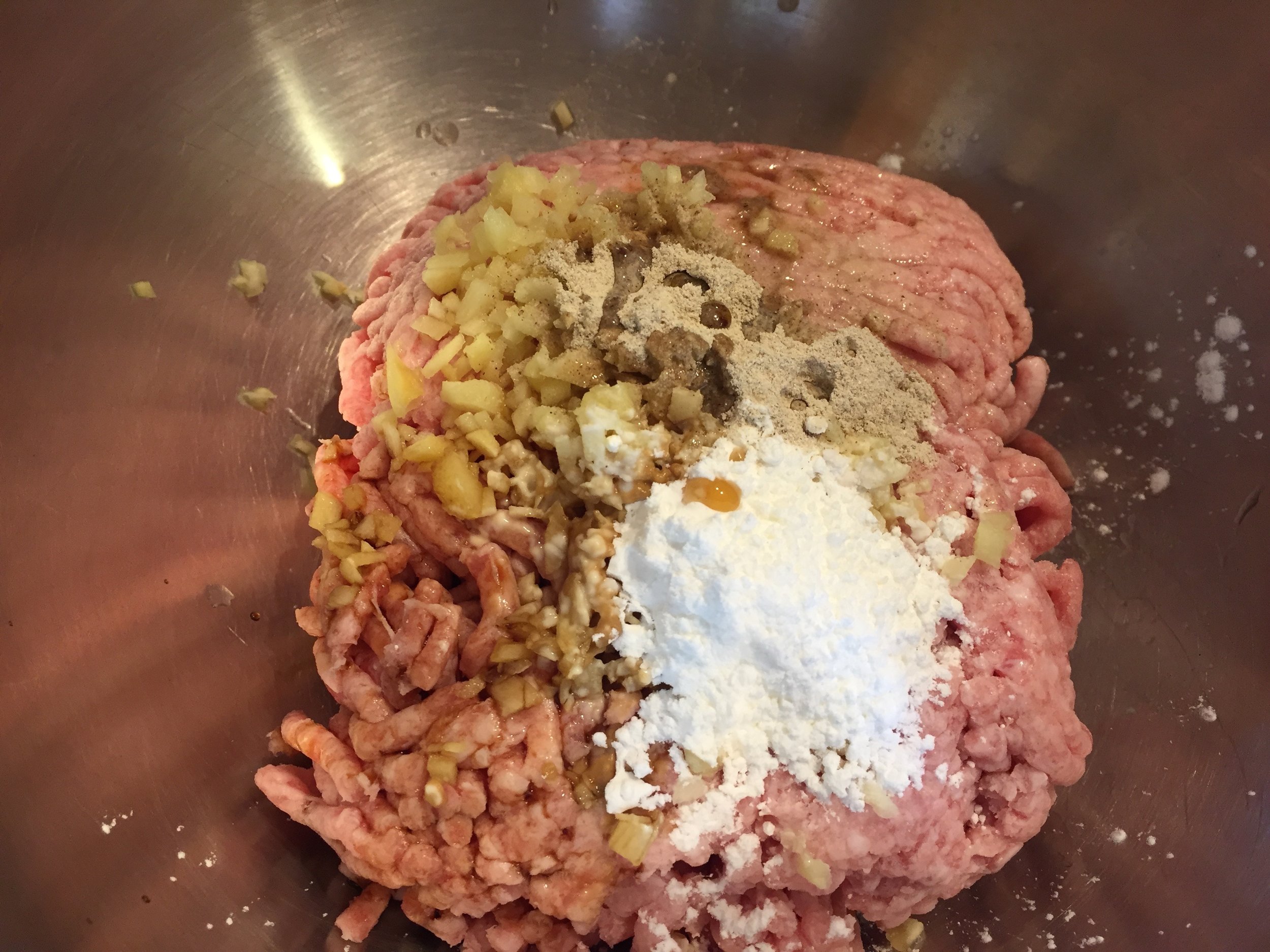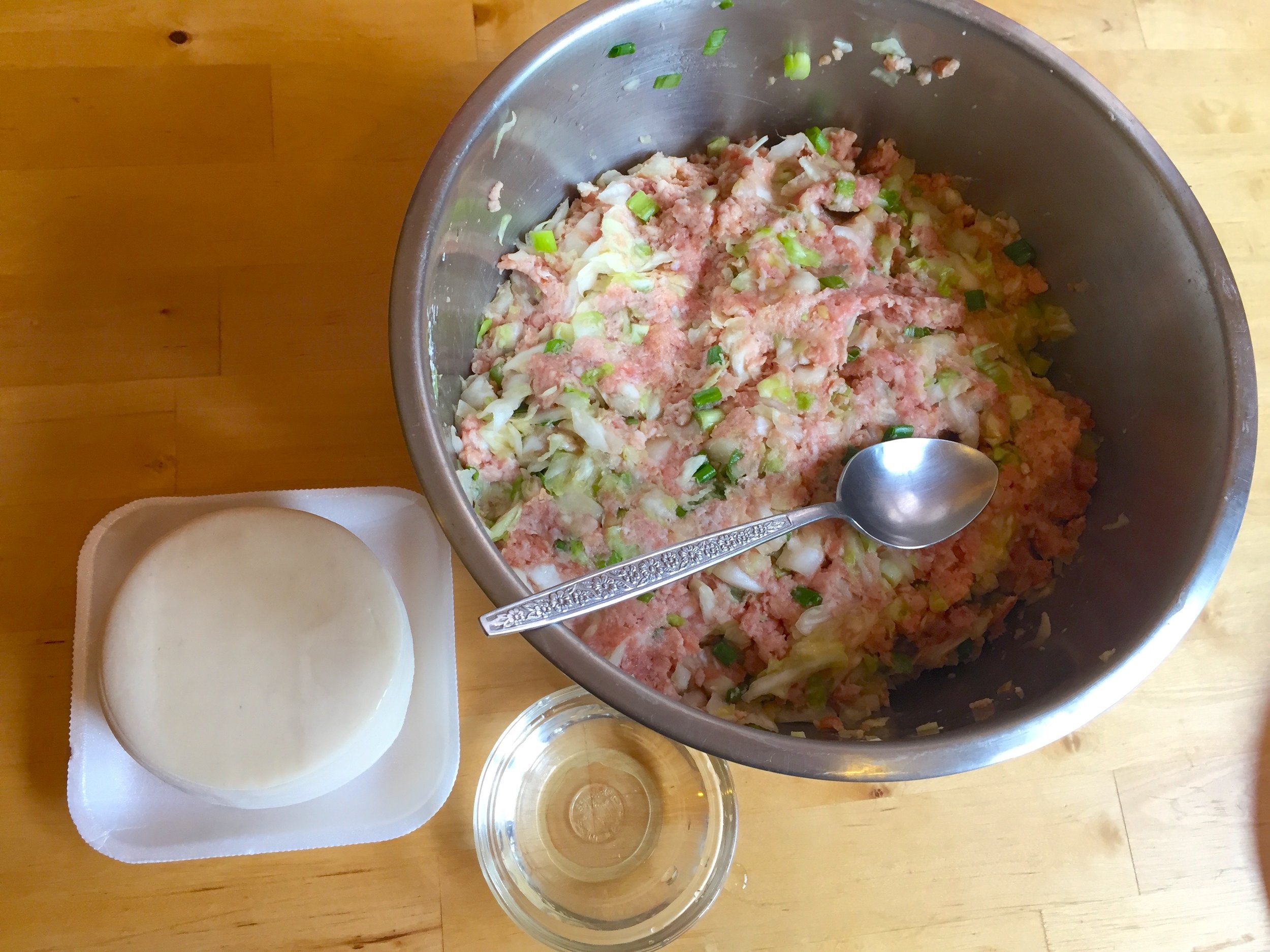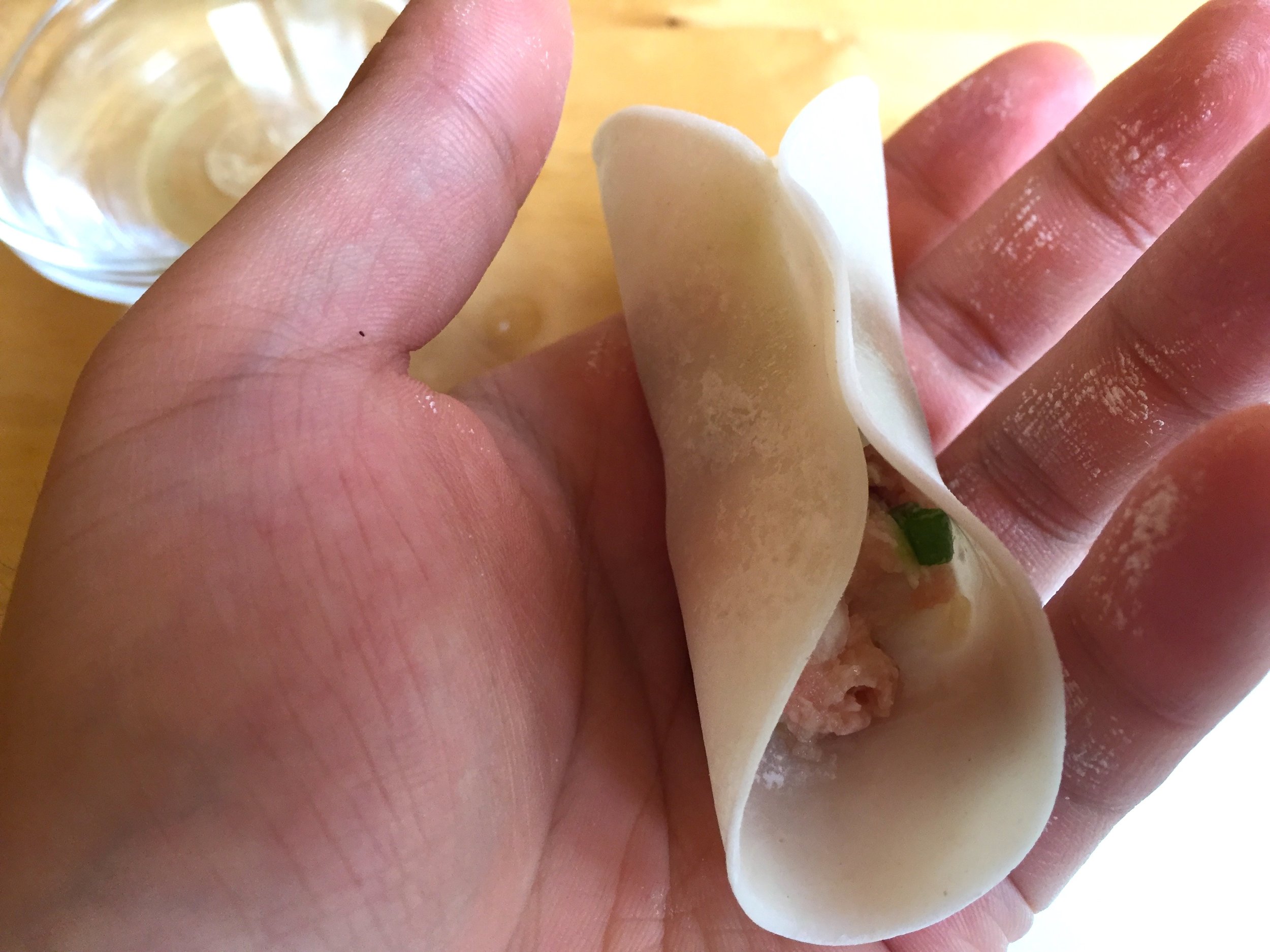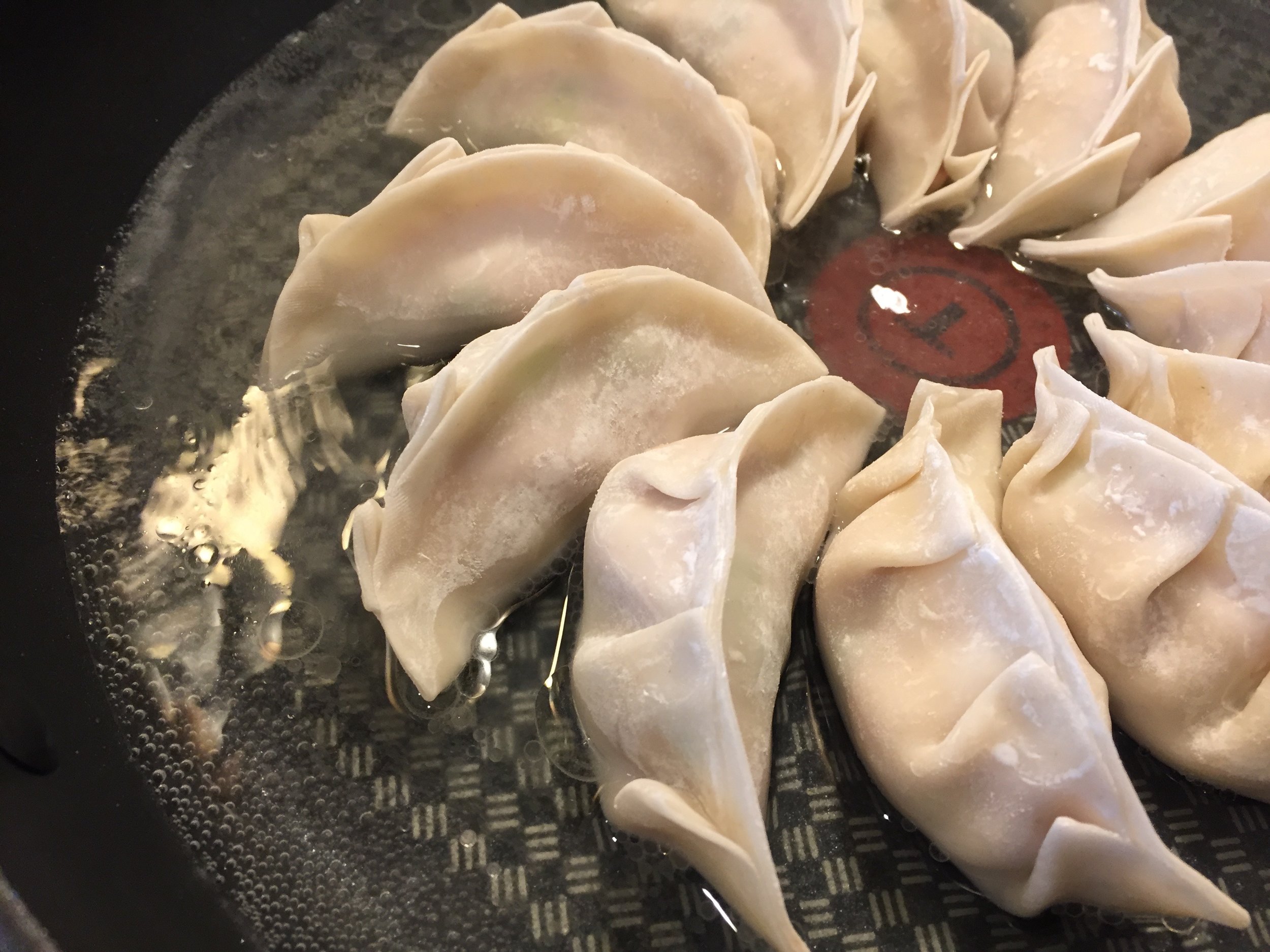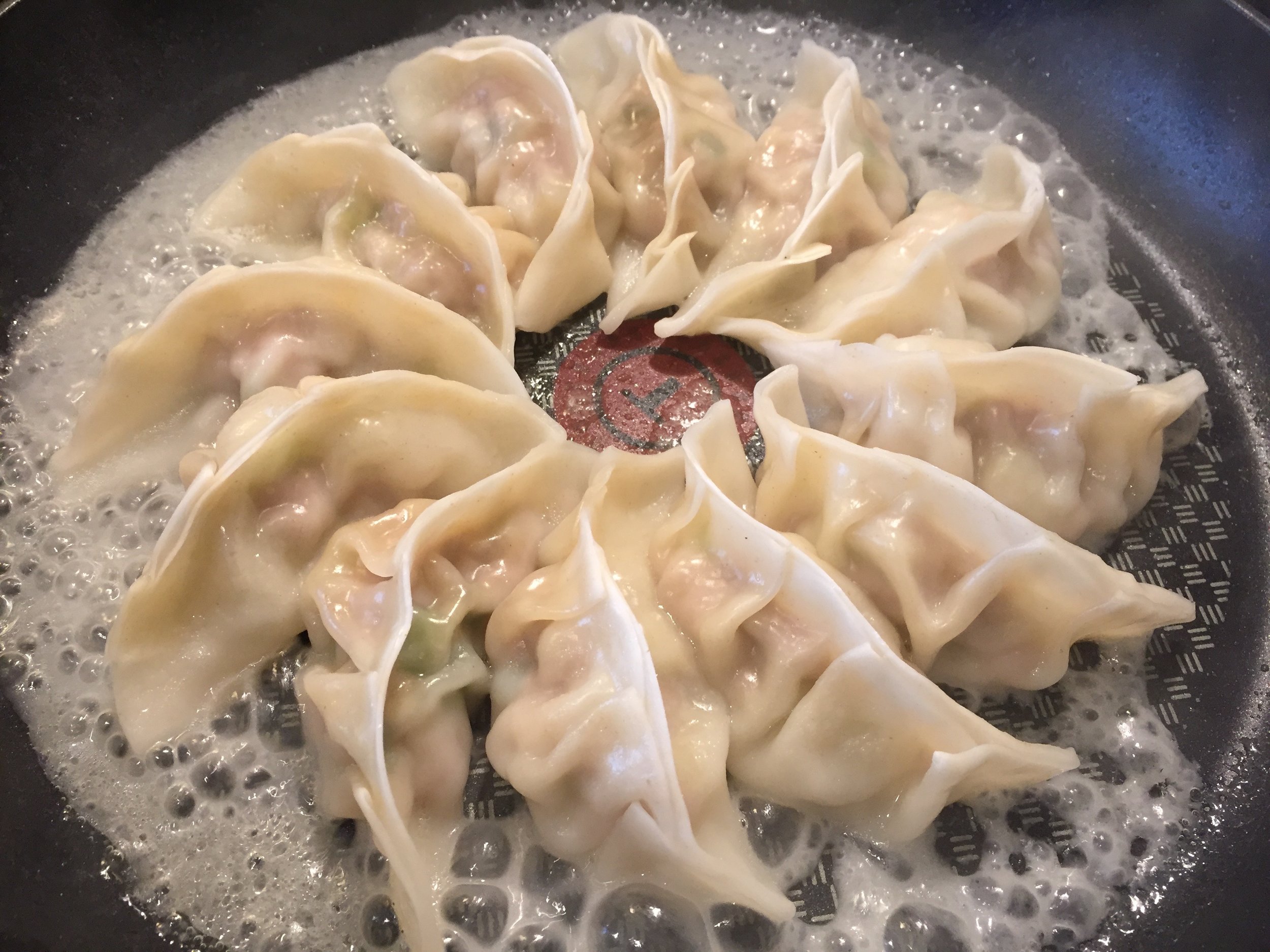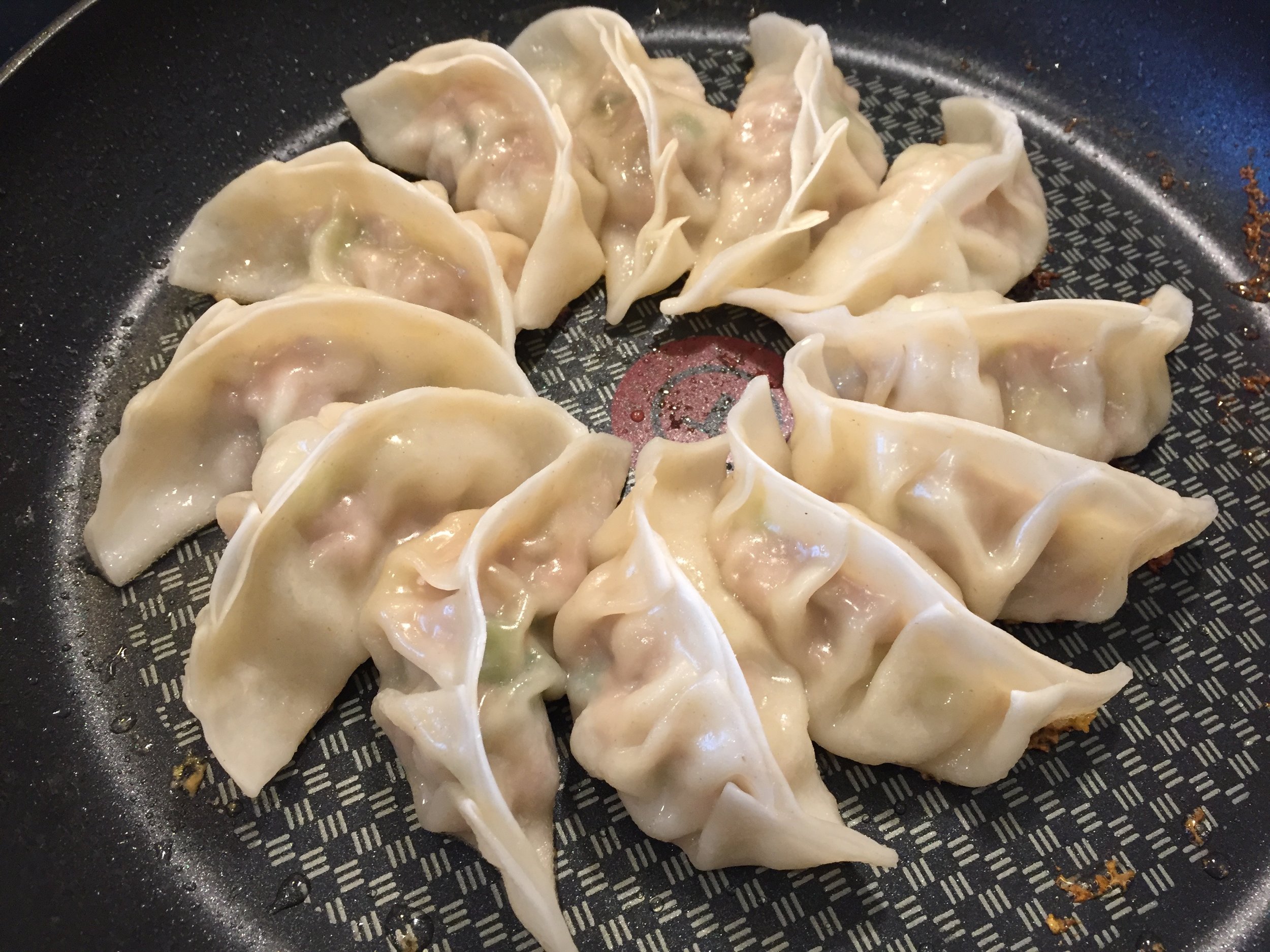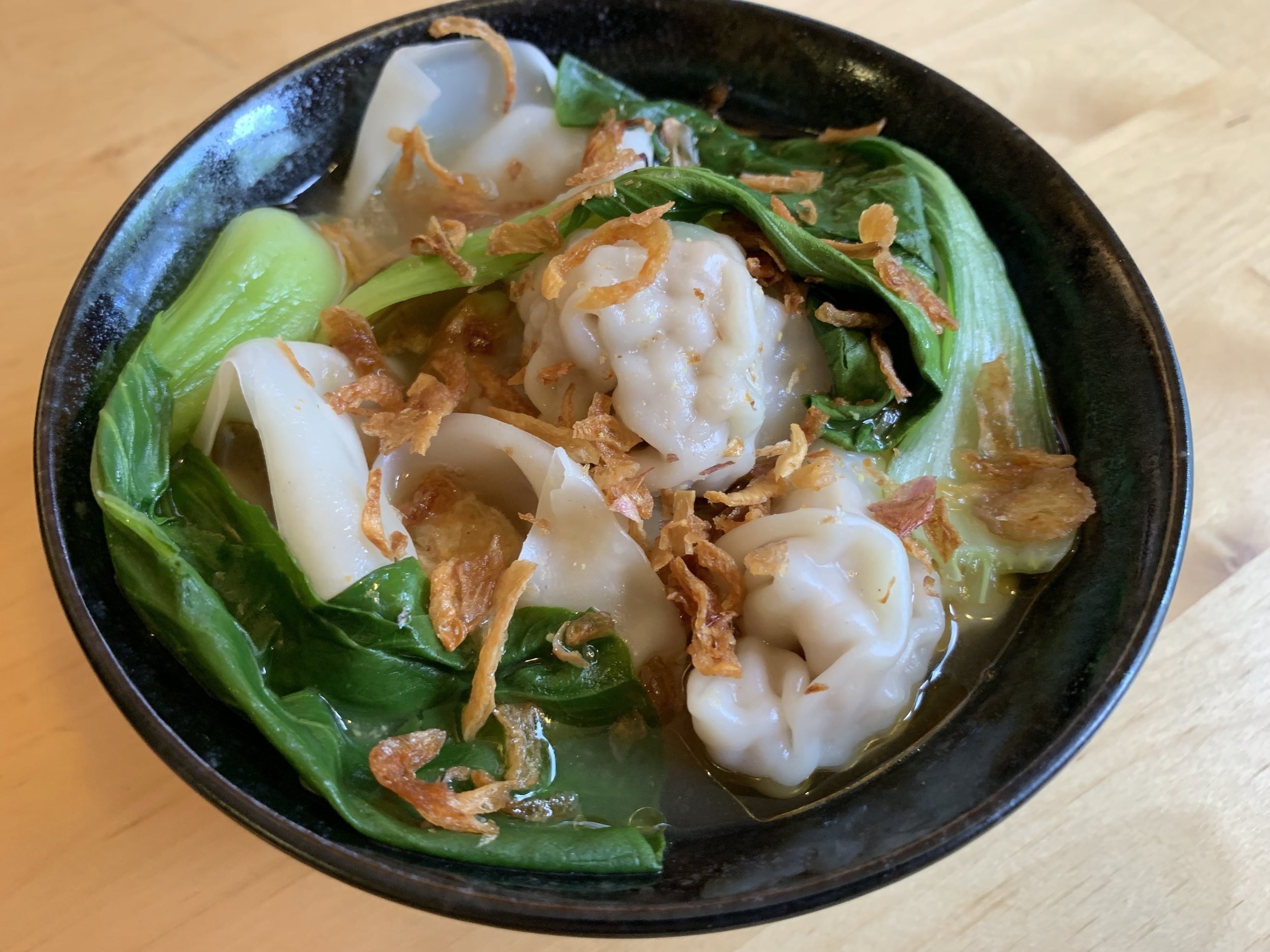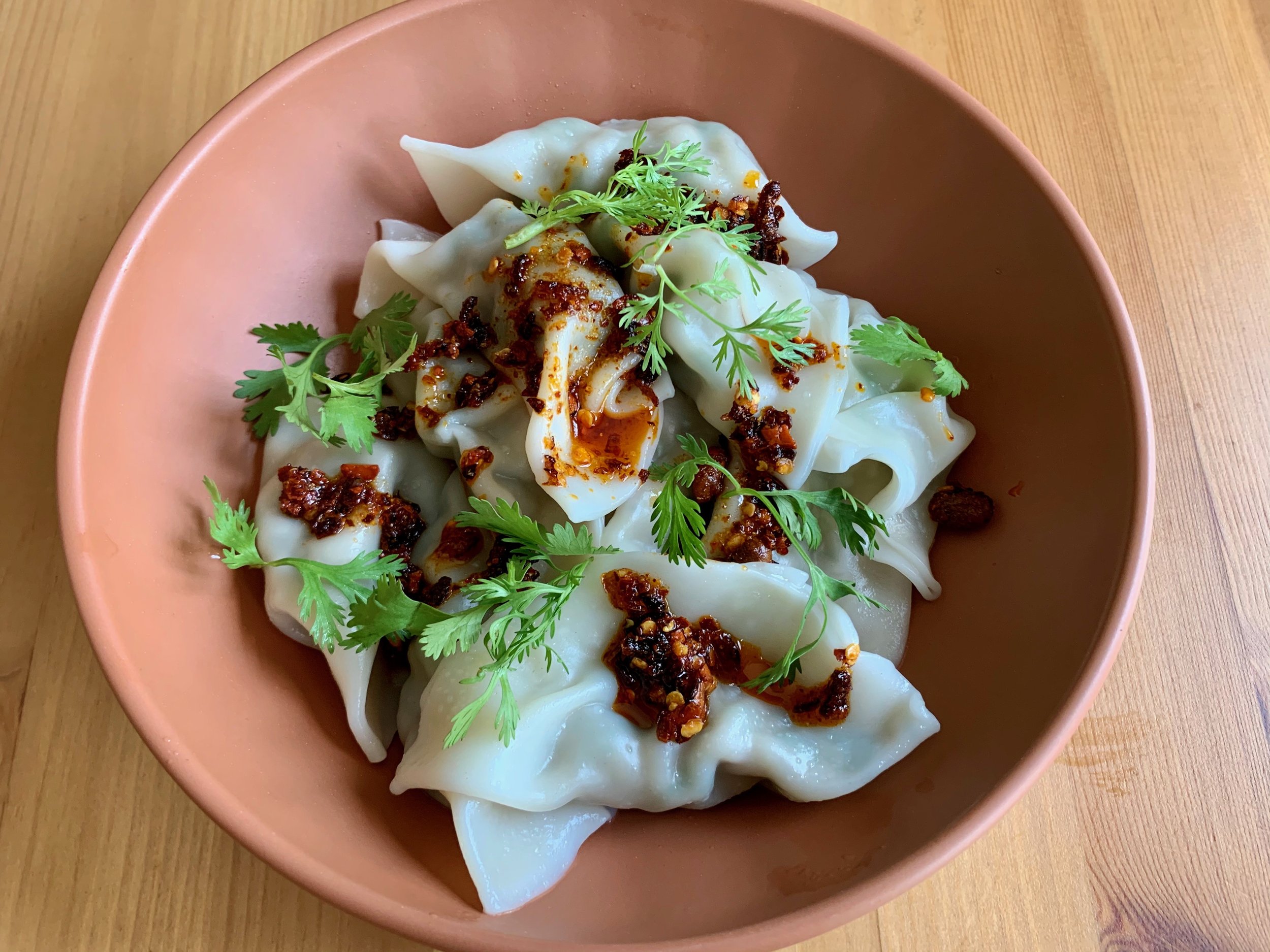Pork and Cabbage Dumplings
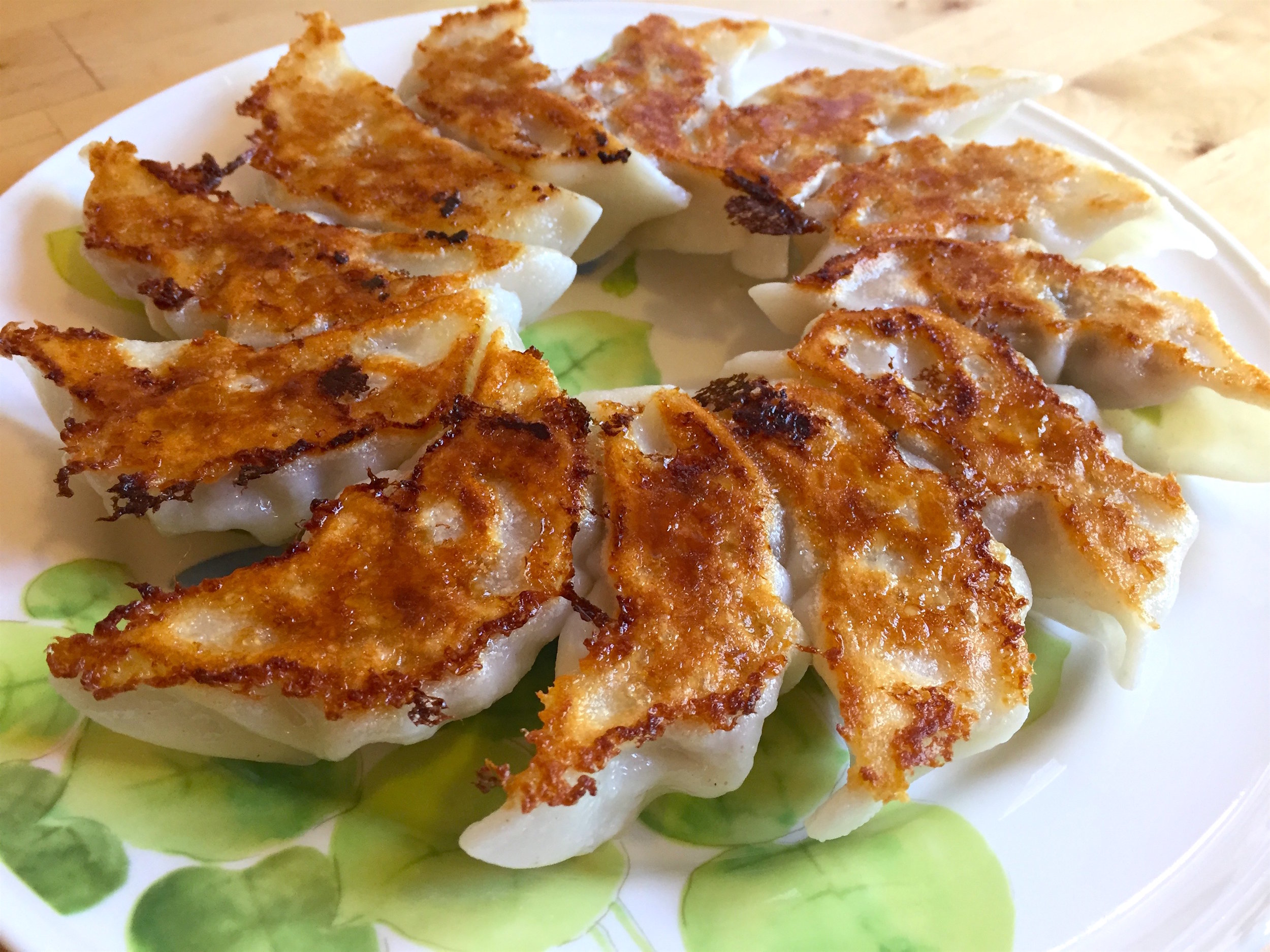
豬肉高麗菜餃子
(Zhu Rou Gao Li Tsai Jiao Zi)
Dumplings are a staple food in Chinese cuisine, found in many forms and with many fillings. Archaeological and historical evidence for dumplings can be found as early as the Han Dynasty.[1] No self-respecting Chinese staple is without an apocryphal origin story, and dumplings have several, featuring frostbitten ears, horns, or the moon.[2] The more likely story, of course, is that early Chinese people, just like every other culture around the world, discovered that there are many benefits to wrapping food in dough—portability, convenience, and increasing the number of meals one could make from a small amount of meat, just to name a few.
While in restaurants in the West dumplings are typically served as an appetizer, in Chinese home cooking dumplings are often served as a main course, for breakfast, lunch, or dinner.[3] Making dumplings at home is much cheaper than restaurant or store-bought dumplings, gives you greater control over the flavor of the final product, and will contain higher-quality ingredients when compared to the fillings you will find in stores. Additionally, they freeze well, giving you a convenient homemade meal if you have made them in advance. Wrapping dumplings together is often a family activity in Chinese households, and it is a great way to spend time with family or friends. The preparation presented here is for one of the traditional fillings—pork and cabbage.
Ingredients
1½ lb ground pork
8 oz Taiwanese cabbage
1 pkg round dumpling wrappers
3 scallions, chopped
1 inch ginger, minced
1 tbsp cornstarch
1 tbsp soy sauce
2 tsp sesame oil
1 tbsp Shaoxing rice wine (optional)
1 tsp white pepper
2 tsp salt
When it comes to dumpling fillings, pretty much anything goes in terms of flavor. However, there are two cardinal rules to constructing a successful dumpling filling: (1) the filling cannot contain too much water, (2) the ingredients must be finely chopped. A wet filling will fall apart when cooking, and too much moisture inside the dumpling will cause problems regardless of how you choose to cook them—bursting from steam pressure when boiled or steamed, or sogginess when pan-fried. Rule two is fairly self explanatory—large chunks of a single ingredient will prevent the filling from binding properly, and also pose puncture hazards to the dumpling skin when wrapping.
With these rules in mind, let us begin by preparing the cabbage. My go-to cabbage for this recipe is Taiwanese cabbage, a sweet and tender variety easily recognized by its flat shape.[4] However, Napa cabbage works well as a substitute, and is in fact the cabbage most commonly used in dumplings in Northern China. Wash and finely chop the cabbage (we are looking for pieces smaller than 1 cm in every dimension). Place the chopped cabbage in a large bowl, and sprinkle over 2 tsp of salt. Mix the salt in with the cabbage, and set aside for 10-15 minutes. The purpose of the salt is to draw moisture out of the cabbage, reducing the amount of water that will end up in the dumplings.
While waiting for the cabbage, finely mince the ginger, and finely chop the scallions. Then add the ginger, scallions, soy sauce, sesame oil, rice wine, white pepper, and cornstarch to the pork. The cornstarch is another layer of insurance against a wet filling, as it will absorb moisture and help bind the filling together.
After 10-15 minutes, the salt will have done its work on the cabbage. With a tea towel or clean hands, squeeze the cabbage dry. Take out all of your stress on the cabbage—by the time you are done, no liquid should be coming out of the cabbage, and the total volume should have shrunk dramatically. Add the cabbage to the pork mixture, discarding the water. Mix the cabbage with the pork using a large spoon or clean hands, until the mixture is homogeneous.
Those of you familiar with making meatballs may worry about over-mixing the meat—a phenomenon where a mix which has been handled too much results in a tough and dry final product. This occurs because mixing ground meat results in proteins cross-linking with each other, similar to the way in which kneading a dough promotes the formation of gluten strands. When cooked, these proteins tighten up, squeezing the moisture out of the meat and leaving the resulting meatballs tough.
In the case of these dumplings, however, we don’t have to worry about over-mixing for two reasons. First, the large pieces of vegetation will resist the tendency of the filling to shrink. Second, the confines of the dumpling are a gentler cooking environment than that most meatballs experience. In fact, for dumplings the main fear is that the filling will fall apart due to the high ratio of vegetables in the filling. Therefore, a fair amount of mixing in this situation is not just alright, it’s beneficial.
At this point you will want to check for seasoning—the best way to do this is to take a small scoop of the filling and microwave it for 30 seconds or so, until it’s fully cooked. Adjust the seasoning to your taste, then prepare to wrap. You can prepare the filling up to two days in advance of wrapping if you wish. Cover tightly and store in the refrigerator.
Onto wrapping. On a clean table or counter, prepare a workspace for assembling the dumplings. The dumpling wrappers, if frozen, should be fully thawed. It is important to stop the wrappers from drying out, so depending on how fast you can work, and how humid the air is, it is often a good idea to keep the wrappers covered before wrapping, either with plastic wrap or a clean tea towel. A towel is also useful for drying your fingers. Fetch a small bowl of cold water for sealing the dumplings, and prepare a landing zone for the completed dumplings. If you plan on cooking them all immediately, just go and pile the dumplings up on a plate, but if you are planning on freezing the dumplings, prepare a plate, cutting board, or sheet pan covered in plastic wrap or parchment paper. The dumplings should be placed in a single layer with a small amount of distance between them so they freeze individually.
Wrapping the dumplings can be an intimidating process if you’ve never done this before, but remember that a dumpling doesn’t have to be picture perfect to be tasty—as long as the dumplings are tightly sealed and there are no large air bubbles, they will cook up great. The simplest shape is a simple half-circle. Moisten the perimeter with water and fold it in half, making sure to push out all the air.
If you want to make them in the traditional crescent shape, however, follow the instructions below. It’ll get faster with practice! On a good day I will average one dumpling every 30 seconds or so—professionals do this at a rate of approximately one every ten seconds.
Begin by placing a wrapper in the palm of your hand, and scooping about 1 tablespoon of filling into the center of the wrapper. The ideal amount of filling will depend on the size of your wrapper, so adjust this amount as you go. With your other hand, dip a finger in the cold water and run it around the whole perimeter, moistening the edge of the wrapper. This very small amount of water is meant to help the wrapper to stick to itself—it should not be enough to form droplets or run. Dry your finger on the towel, and then pinch the wrapper together at the top. Then, begin to seal the dumpling by crimping the seam. Pinch the wrapper to itself on one side, forming a pleat. Then press the pleat back to the other side of the wrapper, sealing it. Repeat this process two or three more times, until one side of the dumpling is sealed. Pleating the dumpling wrapper only on one side creates a gentle curve to the seam. Repeat the process on the other side, being sure that all the air gets out.
When you are done wrapping, if you intend on freezing the dumplings, put your parchment or plastic wrap lined surface into the freezer. After 6 hours or so, the dumplings should be rock solid. Transfer into a zipper storage bag for convenient storage in the freezer.
When it comes to cooking the dumplings, the two most common methods are boiling and pan frying.
To Cook (Boiled)
Boiled dumplings (水餃) are the most common home preparation of dumpling, and the simplest to execute. The only big problem to avoid is the dumplings coming apart when cooking. To avoid this, minimize the turbulence in the water by keeping the pot from reaching a rolling boil.
In a large pot, bring water to a boil. When the water is boiling, add the dumplings to the pot, stirring several times to prevent sticking. As with cooking pasta, use a generous amount of water and do not crowd the pot.
When the pot returns to a boil, turn the heat down to a simmer and cook, covered, until the dumplings are fully cooked. This should be approximately 5-8 minutes if you are cooking them fresh, and 15-20 minutes if you are cooking them from frozen. They are done when the skins turn from white to translucent and the meat inside is fully cooked. Generally the pleated seam is the last part of the skin to be fully cooked, and for potstickers of this size, you can be fairly confident that by the time that the seam is fully cooked through, the rest of the dumpling is also cooked.
Remove from the pot with a slotted spoon, and serve with the dipping sauce of your choice (more on this later).
To Cook (Pan-Fried)
Pan-fried dumplings, known as guo tie (鍋貼), or potstickers, are another common preparation of dumplings.[5] Potstickers come with their own origin story, a cook who allegedly forgot the dumplings boiling on the fire until all the water evaporated and they stuck to the bottom of the wok. The nervous cook then served the ruined dumplings to his master, who praised the cook for his new creation.
Potstickers certainly are a delicious creation, the crisp bottom providing a sharp textural contrast to the steamed top. To prepare your dumplings as potstickers, begin by heating about a tablespoon of oil in a nonstick skillet over medium heat. Add the dumplings in a single layer, frying for about a minute. Once the dumplings hit the skillet, do not move them until the very end. This first fry will help build a crust on the bottom of the dumplings, leading to a crunchier final product after the second fry.
After a minute, add half a cup of water to the skillet, and cover immediately. The water will turn to steam, cooking the dumplings. Continue to cook fully covered for 3-5 minutes before cracking the lid, continuing to cook partially covered until the water is mostly evaporated and the dumplings are cooked through. If you find that the water is disappearing before the dumplings are fully cooked, add another quarter cup of water.
When the water is nearly gone, forming a slurry in the pan with the oil and the flour from the dumpling wrappers, remove the lid and begin occasionally swirling the pan, moving the slurry through and around the dumplings. This action results in more even browning of the potstickers, and reduces spitting in the pan.
Gradually the water will evaporate entirely from the pan. Continue frying the dumplings over medium heat for another 2-3 minutes, until the bottoms of the dumplings are browned and crisp. Once the potstickers are crisp, remove them from the heat and serve them crispy side up.
If you’re looking to show off, arrange them in a circle and turn them out on a plate as a single ring of potstickers, barely connected by a crunchy web and easily separable.
When it comes to dipping sauces for dumplings, different regions have their different preferences. Generally soy sauce based, dipping sauces may also include sesame oil, rice vinegar, chili oil, satay sauce, ginger, and/or garlic. My personal preference when it comes to a dipping sauce for this recipe is 3 parts light soy sauce to 1 part sesame oil and 1 part rice vinegar, but I encourage you to experiment. Other popular accompaniments to dumplings include fresh daikon pickles and finely shredded cabbage.
Substitutions
Ground chicken works well in this recipe in place of ground pork. However, because chicken is very lean, if you use chicken in this recipe you should also add a beaten egg to the mix to help with moisture and binding. Lamb and beef can also be used as dumpling fillings.
If you can’t find Taiwanese cabbage, Napa cabbage and green cabbage work well as substitutes. Also, feel free to experiment with other vegetables. Chinese chives are another traditional vegetable filling, and mushrooms or leeks also work well.
Dumpling wrappers can be found either in the fresh noodle section or in the frozen section of most Asian supermarkets. For this recipe, go for the thicker dumpling wrappers, rather than the thinner wonton wrappers. If you can’t find pre-made dumpling wrappers, or just wish to make your own, follow this recipe here.
[1] 206 BCE-220 CE.
[2] The folk story claims that the phrase for dumpling, “jiao zi,” is derived from the phrase for frostbitten ears, “jiao er.”
[3] Dumplings are traditionally part of Chinese New Year feasts because they are a symbol of prosperity—their shape is reminiscent of yuanbao ingots, a form of currency in Imperial China.
[4] As with every food carrying a country’s name, This cabbage isn’t called by this name in Taiwan. Rather, it is known as Li-Sun cabbage.
[5] In most of the English-speaking world, guo tie are referred to as potstickers. The one exception, strangely enough, is Boston, Massachusetts, where they are often seen on restaurant menus as “Peking Ravioli.” This is a result of Joyce Chen, a Chinese-American restauranteur who opened her first restaurant in nearby Cambridge in 1958. She named her potstickers Peking Ravioli to attract the Italian-American customers common in the Boston area.
Recipe
Prep Time: 1 hr Cook Time: 20 min Total Time: 1 hr 20 min
Difficulty: 3/5
Heat Sources: 1 burner
Equipment: pot or nonstick pan
Servings: 40 dumplings
Ingredients
1½ lb ground pork
8 oz Taiwanese cabbage
1 pkg round dumpling wrappers
3 scallions, chopped
1 inch ginger, minced
1 tbsp cornstarch
1 tbsp soy sauce
2 tsp sesame oil
1 tbsp Shaoxing rice wine (optional)
1 tsp white pepper
2 tsp salt
Instructions
1. Finely chop the cabbage, and place in a large bowl with 2 tsp of salt. Leave the cabbage for 10-15 minutes, so the salt will draw out some of the moisture.
2. In a second large bowl, combine the pork, minced ginger, white pepper, soy sauce, sesame oil, rice wine, cornstarch, and chopped scallions.
3. Squeeze the cabbage to remove excess water. Then add the cabbage to the pork bowl, mixing to complete the filling.
4. To begin assembly, prepare a small bowl of water, and unwrap the dumpling wrappers, keeping them under plastic wrap or a clean tea towel.
5. To wrap, begin with a single wrapper in your hand. Spoon approximately 1 tablespoon of filling in the center of the wrapper, and moisten the edge of the wrapper with water using the tip of your finger. Seal the wrapper, forming a crescent shape.
6. Once all the dumplings are wrapped, cook immediately, or freeze.
To Cook (Boiled)
1. Bring a large pot of water to a boil, and add dumplings to the water.
2. When the pot returns to a boil, reduce the heat and simmer until fully cooked—approximately 8 minutes fresh, or 15-20 minutes frozen.
3. Remove from the pot with a slotted spoon and serve.
To Cook (Pan-Fried)
1. Heat 1 tablespoon of vegetable oil in a non-stick pan on medium heat, and add dumplings, flat side down, in a single layer. Fry for a minute, then add ½ a cup of water to the pan, and cover.
2. Cook covered for 3-5 minutes, letting the dumplings steam. Then crack the lid and continue cooking, partially covered, until the water has nearly all evaporated. If the water runs out before the dumplings are fully cooked, add ¼ cup more water.
3. When the remaining water, oil, and flour from the dumplings begin to form a thick liquid, remove the lid and swirl the liquid around the dumplings. Let the dumplings fry until crisp on the bottom—about 2-3 minutes.
4. Serve crisp side up.


